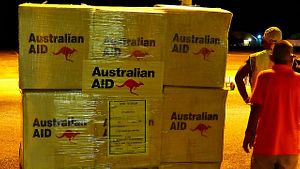In May, Canberra released its new budget. Many were speculating that the previously embattled government of Prime Minister Tony Abbott – which until recently had been languishing behind the opposition Labor Party in the polls – would be set for a post-budget shakeup if his ratings didn’t improve. They have. And the 2015 budget (key elements here) was a crowd pleaser, with no big losers. With one exception.
The budget cut one billion dollars from the country’s aid program. A full 60 percent of that figure is being cut from the Asia-Pacific region. The biggest loser here was Indonesia, where aid was cut by $219.5 million. This follows through on threats to cut aid in response to the execution of two Australians convicted of drug smuggling earlier this year.
Papua New Guinea and Cambodia, which have played key roles in the Canberra’s “stop the boats” policy in their willingness to accept boat arrivals, were insulated from the cuts, with PNG taking over from Indonesia as the biggest recipient of Australian aid.
Since coming to office in 2013, the Abbott government has announced a whopping A$11.3 billion ($8.8 billion) in cuts to aid (see graphics here). Those decisions have been driven by changing trends in global aid, a slowing Australian economy and a firmer outlook that ties aid to trade.
Alex Oliver, a researcher at the Lowy Institute, an Australian think tank, noted that the new budget was one of Dickensian proportions: bad for aid, slightly better for diplomatic posts.
Canberra earlier scrapped the country’s AusAid program, merging it with the Department of Foreign Affairs and Trade. That move has resulted in a cut of 500 staff (10 percent of department staff) since the last 2014 budget. Those staff cuts have been defended by the government as making its diplomatic network “more agile.” The merger has caused what Peter Varghese, the department’s secretary, has called an “unsettled period.” That’s a euphemism for a lot of disgruntled staff. To calm the waters it is perhaps not surprising then that the budget announced $100 million for five new diplomatic posts. It is the single largest expansion of Australia’s diplomatic network in forty years, bringing Australians diplomatic missions to a clean total – albeit significantly fewer than the OECD average – of 100. New missions will be set up in Doha (Qatar), Makassar (Indonesia), Phuket (Thailand), Ulaanbaatar (Mongolia), and Buka, (PNG).
Yet that announcement came with its own problems. The Buka mission anticipates a referendum for independence sometime in the next five years in PNG’s Autonomous Region of Bougainville. Understandably, it has caused a diplomatic spat with PNG. “There has been no consultation” on the issue, said PNG’s Prime Minister Peter O’Neill. In reply, Port Moresby has slapped a travel ban on Australians travelling to the province. And Canberra, which had hoped that insulating PNG from aid cuts would soften the blow, has had to express “regret” for the unintended “problem with communication” over the mission and reaffirmed its respect for PNG’s sovereignty. The PNG relationship is important for Australian companies engaged in the extractives industry and, crucially, it underpins Canberra’s tough immigration policy. Moreover, PNG, which has three diplomatic missions in Australia, has been estimated (somewhat controversially) as delivering the world’s highest economic growth in 2015. It is a spat that will need a quick resolution.
That dispute aside, the opening of new diplomatic missions is long overdue and good news for the country’s small diplomatic network. A 2009 report by the Lowy Institute, titled Australia’s Diplomatic Deficit, recommended significant changes to improve the country’s diplomatic network. Those recommendations included 20 new diplomatic mission over 10 years, new staff, and a focus on new media and digital diplomacy, among others. This budget addresses one of those sensible, and largely unfulfilled, recommendations in part.
Separately, Australian Foreign Minister Julie Bishop is leading the way in trying to improve the country’s digital diplomacy (see her Buzzfeed emoji interview or her Twitter feed), but DFAT still lacks the confidence to boldly improve in this area. Recent trends suggest that e-diplomacy – which speaks to wider public audiences who increasingly shape government decisions – is the shape of things to come. Learning from the trendsetters in this field – Sweden, France, the U.K., and, to different ends, Russia (see Moscow’s 2014 digital diplomacy trends here) – will be important and likely more cost-efficient moving forward.
Australia’s diplomacy is indeed going through an “unsettled period.” With the financial pressures on governments globally, it is somewhat understandable. But Canberra still needs to go further in improving its presence internationally. Cutting aid by a billion dollars and opening a few diplomatic missions may improve top end diplomacy but it won’t reach the millions of people that Australian aid dollars once did. Significant investment in digital diplomacy could help fill that gap.
Canberra is all too aware that it sits between a rock and a hard place in balancing its economic relations with China, Japan, and its relations with the U.S. and the wider Indo-Pacific region. In balancing this tangle of relations it will no doubt need a “more agile” diplomacy, but it will also need to increase its diplomatic presence by making it smarter and, inevitably, bigger.

































